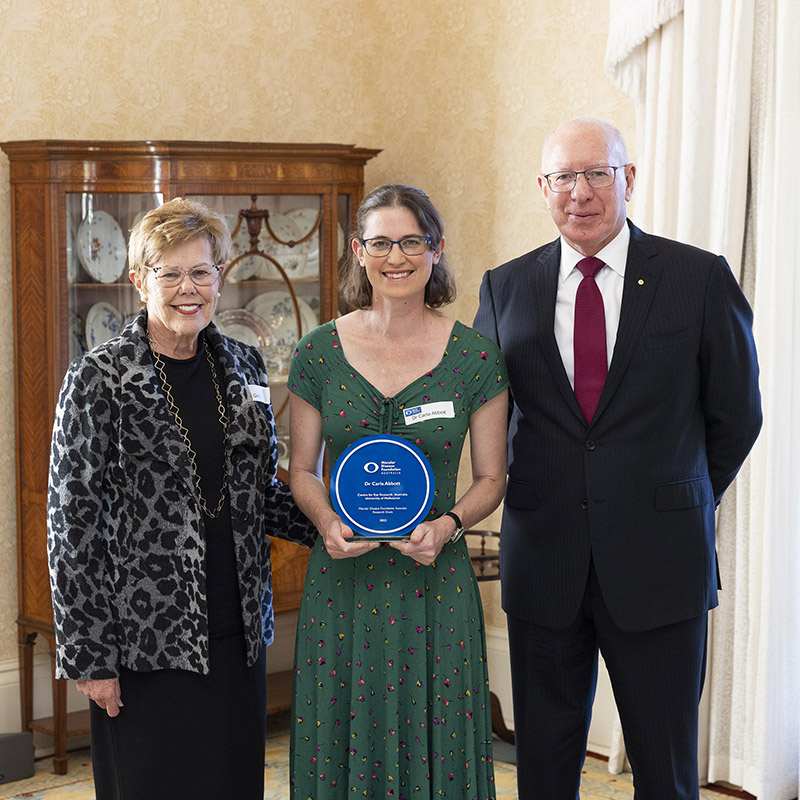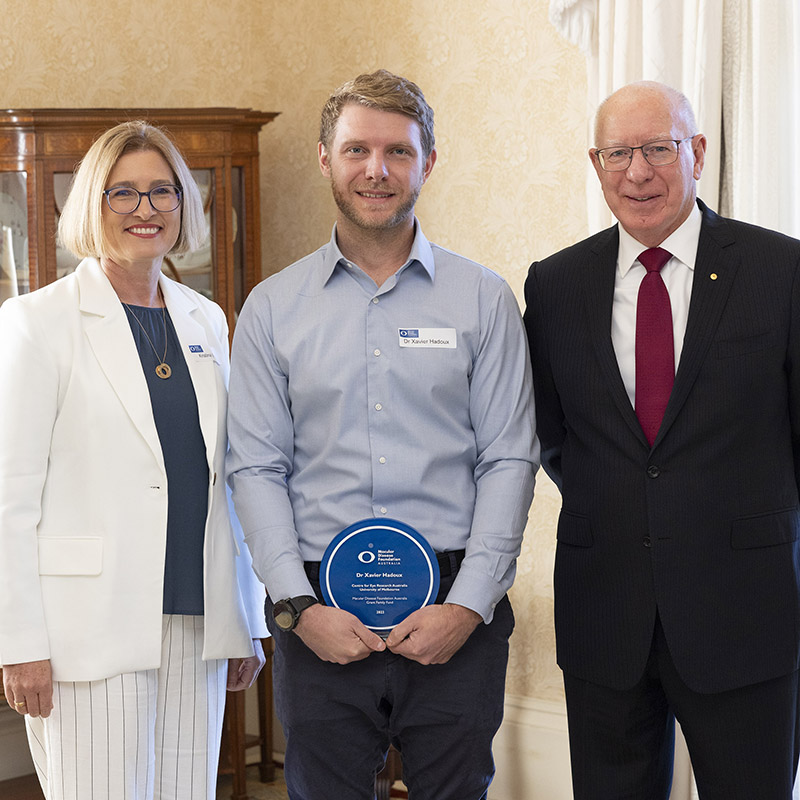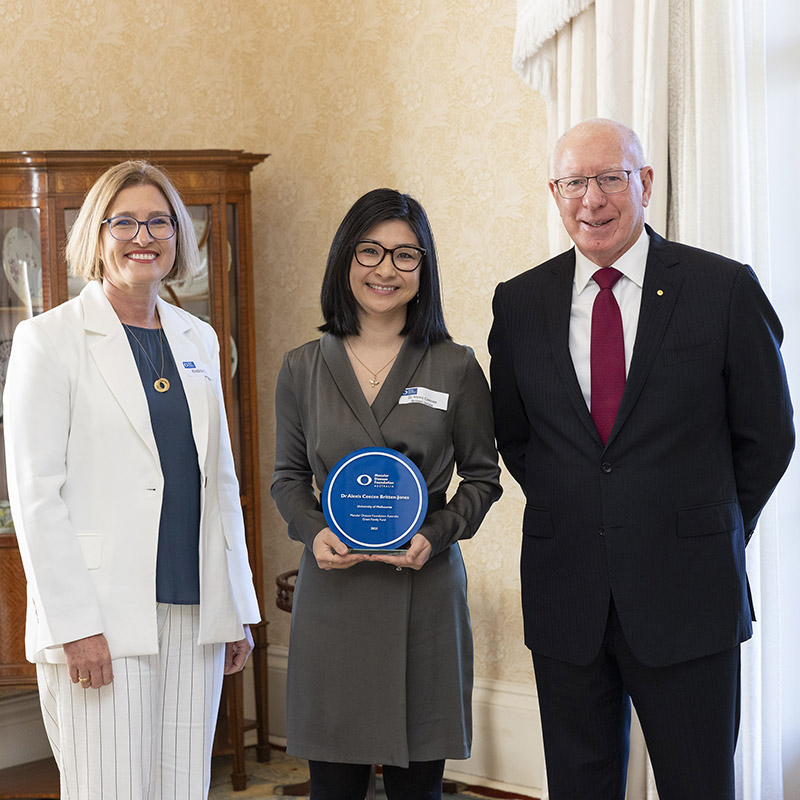News
New support drives macular projects
Three projects taking very different approaches towards improving how macular diseases are treated have been supported by Macular Disease Foundation in their 2023 Research Grants Program.
From understanding the potential role of cholesterol in age-related macular degeneration (AMD) to developing a new method to predict how the disease progresses – three CERA projects have received support from the Macular Disease Foundation Australia’s (MDFA) 2023 Research Grants Program.
Dr Carla Abbott, Dr Xavier Hadoux and Dr Alexis (Ceecee) Britten-Jones accepted their MDFA Research Grants from His Excellency General the Honourable David Hurley AC DSC (Retd), Governor-General of the Commonwealth of Australia, on 16 June 2023 in a ceremony at Admiralty House in Sydney.
While each project is very different, all work towards the same goal of improving how macular diseases are understood and treated.

Cholesterol and AMD
Cholesterol levels have an impact on many diseases, but how it affects AMD is not yet fully understood.
‘Good cholesterol’ – which is also called high density lipoprotein (HDL) – protects against heart disease and cell death.
Its benefits include being anti-inflammatory and helping flush out ‘bad cholesterol’ from the body.
However, in AMD the function of HDL appears to change.
“Preliminary data from our study shows people with AMD have a higher level of dysfunctional HDL compared to those without AMD,” says Dr Carla Abbott, Senior Research Fellow and grant recipient.
“That means you no longer benefit from its protective function.”
Dr Abbott’s project aims to build on these results to understand exactly how HDL is linked to the disease.
In collaboration with Dr Manisha Shah, the team will analyse blood-plasma samples from people with and without AMD to compare levels of dysfunctional HDL.
They will also look at whether the severity of AMD – early or late stage – is connected to HDL dysfunction, and then investigate how this affects the disease.
“This will increase our understanding of how AMD develops and inform potential future treatments aiming to improve HDL function,” says Dr Abbott.
“If we can restore the functionality of HDL, we could apply that treatment in early-stage AMD.”
Dr Abbott says the project is the culmination of a team effort between clinic and lab that began in a collaboration with Dr Hitesh Peshavariya, then Principal Researcher and Head of CERA’s Oxidant Signalling group.
When Dr Peshavariya sadly passed away in 2017, the team of Dr Manish Shah, Professor Robyn Guymer AM and Associate Professor Chi Luu were determined to continue the work.
After funding from BrightFocus helped them find some promising early results, Professor Guymer handed the baton to Dr Abbott late last year.
“Thanks to the MDFA grant, we can look at the levels of HDL dysfunction in AMD in great detail,” she says.

Mapping AMD’s progress
With potential treatments emerging for dry AMD, clinicians and researchers need to find the patients most likely to benefit.
Thanks to MDFA funding, Postdoctoral Research Fellow Dr Xavier Hadoux and the Ophthalmic Neuroscience team will use their hyperspectral camera to scan the retinas of people with the sight-threatening stage of dry AMD to find these patients.
“We’re lucky to already have some images, as the Macular Research team used our camera to scan people’s retinas over a two-year period,” says Dr Hadoux.
Using the same principles as NASA cameras that image the Earth from satellites, the hyperspectral camera uses a series of 30 flashes of different colours, each one capturing a photograph, to collect a lot of data.
“Different parts of the retina respond to light differently,” says Dr Hadoux.
“So different colours of light scatter and are absorbed differently, depending on the type of tissue.”
In AMD, the unhealthy cells absorb a lot of light and appear in images as orange spots or patches.
Then using artificial intelligence, the team will compress these 30 images to create a ‘heat map’ of the areas at risk of being affected next to predict how the disease could progress.
“If you can identify markers of cells that are unhealthy but still alive, we can then determine if potential treatments can save these ‘at risk’ areas,” says Dr Hadoux.
“Based on early data, we believe we can predict the areas where cell death is likely to occur.”

Redefining macular diagnoses
People with rare inherited macular dystrophies, also known as inherited retinal diseases (IRDs), have often been misdiagnosed as having the more common AMD, especially at a later age.
“On examination, these two diseases can appear very similar, but genetically they are very different,” says Dr Ceecee Britten-Jones, project lead and CERA Honorary Research Fellow.
With treatments now being developed for both IRDs and AMD, Dr Britten-Jones and the team will use the MDFA grant with the aim of improving how people with macular diseases are diagnosed.
“We want to firstly make sure they get the correct diagnosis, can participate in the right trials for them and eventually receive the right treatment for their condition,” she says.
This study will be the first to provide information on how widespread the misdiagnosis of macular diseases is in the community.
“We have participants who were first referred to Macular Research as having AMD,” says Dr Britten-Jones.
“After examination, Professor Guymer believed they may instead have an IRD.
“And after performing genetic testing, we confirmed this to be true.”
The study draws on Dr Britten-Jones’ experience as a co-leader of VENTURE – a collaborative study with the University of Melbourne aiming to understand the natural history of IRDs.
She will work alongside Associate Professor Lauren Ayton who is also a leader of the VENTURE study.
CERA Honorary Researcher Associate Professor Heather Mack is also conducting screening of patients with macular disease from private clinics to reach even more people.
They will investigate the genetic changes associated with both types of macular diseases, and then compare confirmed cases to identify features that could help clinicians spot the differences between AMD from IRDs.
“Once we better understand the features that help differentiate macular dystrophies from AMD, we can help other clinicians to better diagnose macular diseases so more patients can eventually get the right treatment,” says Dr Britten-Jones.
